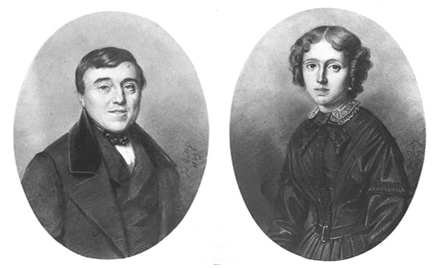
最新の記事
 ブリヂストン美術館がカイユボットの《イエールの平原》を新所蔵&展示
ブリヂストン美術館がカイユボットの《イエールの平原》を新所蔵&展示
ランダム表示
- 2015年2月 (2)
- 2014年12月 (4)
- 2014年11月 (2)
- 2014年5月 (2)
- 2014年3月 (1)
- 2013年12月 (3)
- 2013年11月 (1)
- 2013年10月 (1)
- 2013年8月 (2)
- 2013年3月 (3)
- 2013年2月 (2)
- 2013年1月 (3)
- 2012年9月 (3)
- 2012年4月 (1)
- 2012年2月 (2)
- 2011年10月 (4)
- 2011年9月 (5)
- 2011年8月 (5)
- 2011年7月 (8)
- 2011年4月 (2)
- 2011年2月 (1)
- 2010年12月 (2)
- 2010年10月 (3)
- 2010年9月 (4)
- 2010年8月 (2)
- 2010年7月 (5)
- 2010年6月 (6)
- 2009年11月 (1)
- 2009年6月 (30)
- 2009年3月 (1)
- 2009年2月 (4)
- 2009年1月 (6)
- 2008年12月 (6)
- 2008年11月 (6)
- 2008年10月 (12)
- 2008年9月 (1)
- 2008年7月 (1)
- 2008年6月 (11)
- 2008年5月 (3)
- 2008年3月 (9)
- 2008年2月 (2)
- 2008年1月 (8)
- 2007年12月 (1)
- 2007年11月 (4)
- 2007年9月 (9)

サザビーズの「イエールの谷」訳
サザビーズのモンソー公園の訳に続いて「イエールの谷」を翻訳したでござる。
なるほど大胆な風景画だったんですね。
それで印象派展にだしたのかな。
これがその当時どのくらい大胆だったかなんて現代の我々にはわからないのは残念だなぁ。
サザビーズの元ページはこちら >>

【由来】
パリ、アーネスト=メイ。1879年に購入、1921年まで所有。
パリ、アンドレ=モーリス。1955年頃購入。
パリ、デュルオ・リシュリューの「近代絵画」にて個人に売却(1991年4月15日)。ロットナンバー28。
落札予想価格:$1,000,000 – $1,500,000 (9千5百万円〜1億4千万円)
販売価格:$1,142,500(1億1千万円)
※日本円は参考です。売却当時のレートとは異なります。
〜中略(展示展覧会、文献)〜
【作品について】
1860年、カイユボットの父親はパリの南東にある緑豊かな渓谷イエールの土地を購入した。
若いカイユボットはその地所の周りの19世紀初頭風の公園や向こうに広がる丘々をすぐに気に入った。
イエールの風景はプティ=ジャンヌヴィリエの庭と共に画家の作品の中によく描かれるようになる。
カイユボットは「イエールの谷」の中で、谷のパターン化された風景を描くためにパステルを重ねた。
この画家の初期の風景画によく見られるように地平線を高い位置に持ってきて、大胆で近代的な表現をすることで19世紀末の風景画にありがちな表現を避けている。
ピエール・ウィットマーはカイユボットにおけるイエールの重要性をこのように述べている。
「イエール川はその地理と名景によって、モネにとってのエプトやセザンヌにとってのサント・ヴィクトワールと同じくらいカイユボットにとって重要な場所であった。画家は自分の世界の現実性を自分のニーズに合わせている。ギュスターヴ・カイユボットは自分の過ごした土地に新しく、オリジナリティがあり、そして全く個人的な側面を与えたのだ。田舎の生活はその永続的に繰り返され、そして常に過ぎゆく日々や四季のリズムを感じさせる自然を思い起こさせる。 (P. Wittmer, op. cit., p. 28).」
「イエールの谷」は1879年の第4回印象派展に出展されました。開催場所はオペラ通り28番地で、カイユボット、ドガ、モネ、ピサロといった独創性に富んだ作品が出された。カイユボットは第4回印象派展の組織の重要な役割を担っていた。
Ernest May, Paris (acquired by 1879 and until 1921)
André Maurice, Paris (acquired circa 1955)
Sale: Drouot Richelieu, Paris, Tableaux modernes, April 15, 1991, lot 28
Private Collection (acquired at the above sale)
【Exhibited】
Paris, La 4e Exposition de peinture, 1879, no. 28
Paris, Salon d’Automne, Caillebotte: Exposition retrospective, 1921, no. 2743
【Literature】
Marie Berhaut, Gustave Caillebotte, Paris, 1951, no. 81 (as dating from 1878)
Marie Berhaut, Caillebotte, sa vie et son oeuvre: Catalogue raisonné des peintures et pastels, Paris, 1978, no. 99, illustrated p. 116
Sophie Monneret, Impressionnisme et son époque, vol. III, Paris, 1980, listed p. 151
Pierre Wittmer, Caillebotte and His Garden at Yerres, New York, 1991, listed p. 308
Marie Berhaut, Gustave Caillebotte: Catalogue raisonné des peintures et pastels, Paris, 1994, no. 92, illustrated p. 107
Eric Darragon, Caillebotte, Paris, 1994, illustrated pp. 16-17
Ruth Berson, ed., The New Painting. Impressionism, 1874-1886: Documentation, vol. 2, San Francisco, 1996, no. IV-28, illustrated p. 125
Gustave Caillebotte: The Unknown Impressionist (exhibition catalogue), London, Royal Academy of Arts, listed p. 210
Pierre Sanchez, Dictionnaire du Salon d’Automne: répertoire des exposants et liste des oeuvres presentées, 1903-1945, vol 1, Dijon, 2006, listed p. 271
【Catalogue Note】
In 1860, Caillebotte’s father acquired a property in Yerres, a verdant river valley southeast of Paris. The young Caillebotte was instantly taken with the early nineteenth century gardens around the estate and the expanse of rolling hills that extended beyond. The landscape at Yerres, along with the gardens at Petit Gennevilliers, would figure prominently in the artist’s oeuvre. In La Vallée de l’Yerres, Caillebotte layers rich pastels to convey the patterned landscape of the valley. With a high horizon line, characteristic of many of the artist’s early landscapes, Caillebotte eschews the common expectations of landscape painting at the end of the nineteenth century with a boldly modern gesture.
Pierre Wittmer writes of the significance which Yerres held for Caillebotte, “The Yerres river – thanks to its location and scenic attraction… – was as important to Gustave Caillebotte as the Epte was to Claude Monet or Mont Saint-Victoire was to Paul Cézanne. The artist adapts the reality of his world to his needs. Gustave Caillebotte gave the sites in which he lived a new and original and wholly personal dimension. His rendering of rural life evokes its perennial and cyclic nature, always leaving us with a sense of the rhythm of passing days and seasons” (P. Wittmer, op. cit., p. 28).
La Vallée de l’Yerres was included in the fourth group exhibition which the Impressionists mounted in 1879. The exhibition took place at 28 avenue de l’Opera and included seminal works by Caillebotte, Degas, Monet and Pissarro. Caillebotte himself assumed an important role in organizing this fourth Impressionist group exhibition.
(quoted from Sotheby’s)
サザビーズの「モンソー公園」訳
以前にクリスティーズで売りに出されていた「牡蠣の静物画」についての翻訳をお届けしましたが
先日サザビーズでも「モンソー公園」のオークションがあったようなのでまた翻訳してみました。

過去に取り扱われた作品もそれなりにあるし、また読んでみなくっちゃ!!
サザビーズの元ページはこちら >>
翻訳中の「図」については元ページをご覧下さい。
それではレッツ!
【由来】
パリ、オテル・デュルオの1877年5月28日の印象派作品売却にて。ロットナンバー4。
ロンドンのDudley Toothが1960年代に購入。
1972年現在の所有者に渡る。
落札予想価格:?800,000 – ?1,000,000 (7千万円〜1億4000万円)
販売価格:?2,617,250(3億6千万円)
〜中略(文献)〜
【作品について】
この作品は、ミロメニル通りのカイユボットの家にほど近い、パリ8区にあるモンソー公園(図2)を描いたとされるたった2枚の作品のうちの1枚だ。
こちらの作品ではカイユボットは、短く素早い筆致を使うことで青々とした下草を表現し、低木やベンチの周りの光と影の動きを研究し、明るい春の日の公園を描いた。
モンソー公園はオルレアン公の命令によって18世紀後半の英国庭園の様式で設計された公園だ。
元々は個人の私庭だったがオスマン男爵の下の公の公園に変わり、1861年に市民に一般公開された。
ロンドン王立美術館の大回顧展によって「都会の印象派」と名付けられたカイユボットは「公園」に自然と都会への愛好を結びつけるような素晴らしい主題を見いだしたのだ。
ジュリア・サグレイヴスはカイユボットとモネ(図3)の両作品についてこのように書いている。
「カイユボットとその友人モネは同時期にサン・ラザール駅周辺を描き、発表した。二人は、”市民公園\\\\”とりわけモンソー公園というサン・ラザール駅とはまた全く違う種類の近代都市風景への関心を共有しているようにも見える。この公園はカイユボットが1870年代を主に過ごした家からほど近くにあり、元々は18世紀に私的な一風変わった庭として設計されたものだ。フランス革命の間には政府の所有物だと宣言されたのだが、全体的に荒廃し使われなくなりながら約10年間個人の所有で有り続けた。第二帝政の間に政府がそれをきちんと取り戻し修復をして、モンソー公園は”パリのもっとも魅力的な散歩道のひとつ”になったのである。(J. Sagraves in Gustave Caillebotte: The Unknown Impressionist (exhibition catalogue), op. cit., p. 81)」
1870年代を通して、カイユボットとモネはしばしば似たような主題、特にパリとそれを取り巻くものを描いた。
実家が裕福であったカイユボットはこの間モネに経済的援助をし、またいくつかのモネの作品を購入し、コレクションしていった。
ジュリアはこの作品について「筆遣いや構図はモネを思い起こさせる。しかしカイユボットの描写は、モネが描いた公園の光景というよりも、当時カイユボットが所有していた”アパートの室内(図4)”に似ている。両作品には広く平坦な通路(公園の歩道・床)、前面への急な傾斜、作品の中央の断ち落としが見られる。また両作品の通路の終わりには孤独で、妙に小さく、ぼんやりとした人物が植物に覆われ、ほぼ埋められるように立っている。カイユボットはこのようにモンソー公園を描くことで、家の近くにある公園と快適でもあり不吉な感じでもあるプライベートな内面空間をなぞらえたのだ。 (ibid., p. 81)」と述べている。
ファッショナブルな衣服をまとった男女や子供のいるモンソー公園の社会的な側面を描いた(図3)モネと違って、カイユボットは緩やかなカーブの歩道を中心に置きその上に覆うように青々とした下草を描くことで、殆ど内面の幻影であるかのような公園のより孤独な面を表現した。
植物や木々が慎重に描かれていると同時に、こちらに向かって歩いてくる小さな男性の人影を圧倒し、構図を支配している。
大ざっぱで数少ない筆で描かれているが、男性はグレーのスーツと帽子をかぶったパリ紳士と分かる。
さらに、注意深く配置された低木や芝小道や規則正しく配置されたベンチは、都市の雰囲気を醸しだし、同時に力強くダイナミックな構図を作り出している。
Sale: Hôtel Drouot, Paris, Vente des Impressionnistes, 28th May 1877, lot 4
Dudley Tooth, London (acquired in the 1960s)
Thence by descent to the present owner in 1972
【Literature】
Merete Bodelsen, ‘Early Impressionist Sales, 1874-1894 in the Light of Some Unpublished Procès-Verbaux’, in The Burlington Magazine, June 1968, p. 336
Marie Berhaut, Gustave Caillebotte, sa vie et son œuvre. Catalogue raisonné des peintures et pastels, Paris, 1978, no. 58, illustrated p. 101
Pierre Wittmer, Caillebotte au jardin. La Période d’Yerres (1860-1879), Saint-Rémy-en-l’Eau, 1990, p. 242
Marie Berhaut, Gustave Caillebotte. Catalogue raisonné des peintures et pastels, Paris, 1994, no. 64, illustrated p. 97
Gustave Caillebotte: The Unknown Impressionist (exhibition catalogue), Galeries Nationales du Grand Palais, Paris; The Art Institute of Chicago & Los Angeles County Museum of Art, Los Angeles, 1994-95, illustrated p. 151 (in Paris); p. 81 (in Chicago)
【Catalogue Note】
The present work is one of only two known paintings that Caillebotte executed on the subject of Parc Monceau (fig. 2), a public garden located near the artist’s home on rue de Miromesnil, in the eighth arrondissement of Paris. In the present version, Caillebotte has depicted the park on a bright spring day, using short, quick brushstrokes to render its lush undergrowth and to explore the play of light and shadow on the shrubs and around the benches. Commissioned by the Duke of Orléans, Parc Monceau was designed in the style of the English garden in the second half of the eighteenth century. Originally a private garden, it was converted into a public park under Baron Haussmann, and opened to the public in 1861. Caillebotte, labelled by a major retrospective exhibition at the Royal Academy of Arts in London as the ‘urban Impressionist’, found in the park a great subject to paint, as it combined his love of nature with that of the city.
Julia Sagraves wrote about this subject-matter in the work of both Caillebotte and Monet (fig. 3): ‘At the same time that they were painting and exhibiting pictures of the area around Gare Saint-Lazare, Caillebotte and his friend Monet appear also to have shared an interest in another very different kind of urban space: the public city garden, and, in particular, Parc Monceau. The park was located only blocks away from where Caillebotte lived throughout most of the 1870s. It was originally laid out in the eighteenth century as a private, picturesque garden. During the French Revolution, it was declared the property of the State, but in the ensuing decades it continued to pass in and out of private ownership, while also falling into general disrepair and disuse. It was only during the Second Empire, when the State firmly reclaimed and restored it, that Parc Monceau became “one of the most agreeable promenades in Paris”’ (J. Sagraves in Gustave Caillebotte: The Unknown Impressionist (exhibition catalogue), op. cit., p. 81).
Throughout the 1870s, Caillebotte and Monet often chose to paint similar subjects, particularly views of Paris and its environs. Caillebotte, whose family belonged to the affluent grande bourgeoisie, also provided financial support to Monet during this time, and acquired several of Monet’s paintings for his collection. Writing about the present work, Julia Sagraves observed that it ‘recalls Monet in both its brushwork and composition. However, Caillebotte’s image resembles not so much Monet’s own views of the park, but instead his Apartment Interior [fig. 4], which Caillebotte owned at the time. In both works, a wide, smooth passageway (garden path, floor), tipped dramatically forward, cuts through the centre of the picture. At the end of this corridor stands a solitary, strangely diminished, indistinct figure, encased and nearly overwhelmed by the surrounding plant life. In depicting Parc Monceau in this manner, Caillebotte likened the space of his neighbourhood garden to private interior space, at once comforting and menacing’ (ibid., p. 81).
Unlike Monet, whose depictions of the Parc Monceau focused on its social aspect, with groups of fashionably dressed men, women and children (fig. 3), Caillebotte chose to represent a more solitary vision of the park, centred around the gently curving line of the path, and the lush greenery that closes above it, almost creating the illusion of an interior space. While the plants and trees appear to be carefully designed, their wild growth dominates the composition, towering over the small figure of a man who walks down the path towards the viewer. Although executed in a few sketchy brushstrokes, the man, wearing a grey suit and a hat, can be identified as a Parisian gentleman. Furthermore, the meticulously aligned shrubs and grass alleys and the rhythmically spaced benches give the scene its air of urban environment, while at the same time creating a vibrant, dynamic composition.
(quoted from Sotheby’s)
カイユボットの従妹の孫
フランスの方から「カイユボットのこと、ニュースになってたけど知ってる?」と情報をいただきました。
ななな何と心の優しい方なんでしょう!Merci, Bien!
その方の情報と、情報に書いてあった「ouest-france(西仏新聞)」の情報などを元に話を総合(と想像)すると
Caillebotte et Bayeux : une histoire de famille – Bayeux
(カイユボットとバイユー:バイユーの家族の歴史)

写真右側の女性Dominique Bussillet(ドメニク・ビジエ)が2010年3月に本を出したそうです。
タイトルは[Maupassant et l’univers de Caillebotte(モーパッサンとカイユボットの世界)]。
その関係で、カイユボットの子孫と対面したというニュースなんだと思います。
————————————
左の男性がそのカイユボットの子孫、 François Chaplain(フランソワ・シャプラン)氏。
カイユボットの従妹のゾエのお孫さんでフランス北西部のバイユーに住んでいるそうです。
カイユボットはゾエがバイユーの男性と結婚をした時に、自身の作品を三枚プレゼントしたのだそうです。
一枚目は「田舎の肖像」、現在バイユーの美術館が所有しています。

二枚目はフランソワさんの兄弟が所有していたそうですが1997年に売却。
もう一枚がこのフランソワさんが所有している「アルジャントゥイユの風景」、写真の背景に映っている作品です。
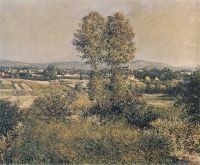
「田舎の肖像」に描かれている4人の女性は、ゾエの娘のスザンヌが「田舎の肖像」のポストカードに残したメモによって判明しています。
————————————
うーん、カイユボットの子孫か!
カイユボットとモーパッサンはボート仲間でした。
ドメニクさんの本には二人の交友とか二人の作品の共通点なんかが書かれているのでしょうか??
売却されたのはどの作品なんでしょうか。
願わくばゾエちゃんが描かれた作品だったらいいなと思いますけど!
この国にもカイユボット作品が!
カイユボットの作品を一番多く所有している国は、ほとんど一生を過ごしたフランスです。
その次はアメリカ。
 例えば、「パリの通り、雨」はシカゴ美術研究所 (Chicago, The Art Institute)が所有しています。
例えば、「パリの通り、雨」はシカゴ美術研究所 (Chicago, The Art Institute)が所有しています。
そんな中、なんとイスラエルにも!

「冬の風景」イスラエル美術館
イスラエル?まっさかーと思ったら、ちゃんと、HPにものっているんですよ。

[ニューヨークのリチャード=ロジン夫妻から、イスラエル美術館の米国友人に寄贈]だそうです。
雪の降らないだろうイスラエルにカイユボットの「雪の風景」。
意外ながらなかなか趣深いモノがあります。
ちなみに、日本にもあるんですよ。
私個人が確認できているものでは1点。(2012/03時点で2点)
よかったら「作品検索」で検索してみて下さいナ!
オルセーにカイユボット作品が集まっている・・・!
久しぶりに、オルセー美術館所有のカイユボット作品をチェックしていたところ、
なんと、収蔵作品が増えていました!

一覧はこちらから検索できます(オルセー美術館/英語)(C-caillebotteで検索して下さい)
もともと持っていたのは
 「床のかんなかけ」
「床のかんなかけ」
 「アルジャントゥイユのヨット」
「アルジャントゥイユのヨット」
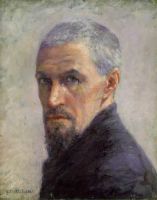 「自画像」
「自画像」
 「雪の屋根」
「雪の屋根」
 「アンリ=コルディエの肖像」
「アンリ=コルディエの肖像」
でした。
※「Attelage de boeufs」はどれのことやら不明
何年に来たのかは分かりませんが、新たに
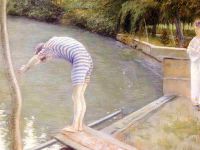 「水浴者」
「水浴者」
がアジャンのエコールデボザール美術館から、
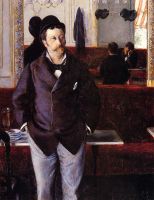 「カフェにて」
「カフェにて」
がルーアンのボザール美術館から
加わったみたいですね!
もしかしたら、オルセーが本気でカイユボット作品の収蔵を始めたんじゃないですか!?
だとしたら、とても楽しみです!
※今国立新美術館で開催中の「オルセー美術館展2010」には
カイユボットの作品はきていないようです。んー残念。
名古屋市美術館でカイユボットが展示されてます
お久しぶりです。
久々のカイユボット情報。
どうも英語が私を苦しめている気がしてならない・・・しばらく日本語のみにしてみようと思います。
そしてですが、
愛知県の名古屋市美術館で現在開催中の「絵画と写真の交差 ―印象派誕生の軌跡―」にてカイユボットの絵画が一点表示されています。
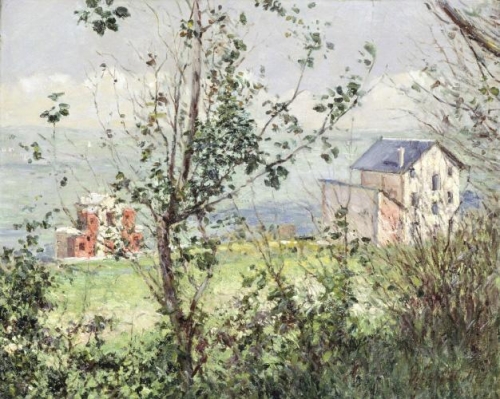
詳細は今週中に書きますね。トゥルーヴィルの風景の作品です。
私の持っている資料では「所蔵:不明」となっていたのですが、現在東京富士美術館が所蔵している模様!
うーん、大発見です。
2009年12月20日(日)までですのでお近くの方は是非いってみてください^0^ノ
5000万円お持ちですか?!
?????????£???????????????????????´???????????×?¬????????????????????????????????
???????????????????£?´?????¢???¬?????´?¶???????£??
?´?????????????????????? >>
?×???????????????¢?§?¬?????????????£
?????????????????????????????????×??????
?¢???????????????????????£´?°????????´?¶???????????´??????????mm
???????¢???????£??
???????????°??????W=???????????????????????????±????????????????????????????????
°????????????????????????£
?????????¢?´?????????????§??????????????????????(^o< ) -??
´????????¢????????????????´??¬?????????????????£

????????????
??????No,7735
°?????/???????¢?????????????°??????
2009/6/23????
?????????¢?????°??????????????
?????????????§??250,000 – ??350,000 (4000??±???5600??±?)
????????????
????????????????????????????1848-1894??
???´???????????×??????????????G. Caillebotte?×
?????????????????¢38 x 55 cm?¢1881??
?????????£????????
???????????????????°?????¬?¬?×??
???´??°???
??????????5%?????????????¢15%?????????¬???????????£
????????????
??????????????????????????
????????
?????¢????????????????????????
?????¢?¢??????????????????????????1900???¢??
?????????¢???¶??????1981/4/2??lot310??
??????????????????????????????????????
?????¬???????????÷??????
????????????????
??????????????1881???????´???????????×?????????£?????¢???????????????????????????????????£
???????????????????????????????????????¢1894???????????????¨?????¢?????????????????????????¢?????????????????????????????????????£
?????????????????????????????¢?????????????????×?????¢???????¢???????????????????????´???¬???????????????£
??????????°??????????????????????¢???????????§???????????????????????????£
°?????????????????°????????????????¢???????????????????????¬????°??????????¢????????????°??£???????????????????????£
?????????????????¢???°??????W=???????????????????¢????????????????????????????°????????°??????????????°?????????????????????°???????¶????????????????????????????????????????????¢??????¶????÷?????????????????????????????????????£??????°???????¶??????????¢???¬???????????£
°??????????????????¢???¶???????±???????????????????????£
???????????????????????????????????????×??±?¶??????¨?¢???????¨???????????????¬1870????????????1880?????°???????±???????????????????????????????????????????????????????????????????????£
?????????????????¶?????????????????±???£??????????????2??????´??¬?¢??????????´??????´???????????×????????1881-82?????¢???????????¬1890??????´??????????????????¢???£
????????????´¶?????????×???£???????????£???¨??°????°???????????¢????????????´?°??????????????????????????????????¨?????????????×?????????????????£
???????????????????£±?????????????´??????¢??????´??????¢???????????×???????????????????????????????????????????????????????????????????????????????×???????????¢???????????????????£
?´?????????????????????????????????????????¢?±?????????????????????????¨?¬????1879?????????????????×?????÷?????????????????????¢????´¶?¬?¢???????????£
???????¢?????????????????????????????¢?£???´???????????¢?????????????????????????????¬?????°????????´±?????????????????´???????????????×????????°??????????¨???£
?????????????????????°???????????????????????????????????£????????????¶???????´¶?????????£
????????????????????????????????????=??????????????????????¶????????????????????£
?????????????????????????????×?????????????????????±?????????¢???????????????????????????????¢???£
?????×?????????????×????????????????????¶??????????????????????????????????????????????¢???????¢????????????????????°??????¬?????£
20?????°?????°±??????????????????????????????????????????????????×???¢?????£
Christie’s will offer a work of Caillebotte ‘Still Life with Oysters’.
(Special thanks for informing me)
Still Life with Oysters >>
The colors are bluer than I imagine.
Please show me if you get it!
I wish a Japanese art museum obtains it.
??Sale Information??
Sale 7735
Impressionist/Modern Art Evening Sale
23 June 2009
London, King Street
??Estimate?? (Set Currency)
??250,000 – ??350,000 ($409,000 – $572,600)
??Lot Description??
Gustave Caillebotte (1848-1894)
Nature morte aux hu???tres
signed ‘G. Caillebotte’ (upper left)
oil on canvas
15 x 21 5/8 in. (38 x 55 cm.)
Painted in 1881
??Lot Condition Report??
You need log-in
??Special Notice??
VAT rate of 5% is payable on hammer price and at 15% on the buyer’s premium
??Pre-Lot Text??
PROPERTY FROM A PRIVATE SWISS COLLECTION
??Provenance??
Martial Caillebotte, Paris.
Ambroise Vollard, Paris, circa 1900.
Anonymous sale, Sotheby’s, London, 2 April 1981, lot 310.
Acquired at the above sale by the present owner.
??Literature??
F. F??±n??±on, ‘Les impressionnistes en 1886’, in Oeuvres, Paris, 1948, no. 2, p. 88.
M. B??±rhaut, Gustave Caillebotte, catalogue des peintures et pastels, Paris, 1951, no. 166.
M. B??±rhaut, Caillebotte, sa vie et son oeuvre, catalogue raisonn??± des peintures et pastels, Paris, 1978, no. 180, p. 55 (illustrated p. 142).
M.J. de Balanda, Gustave Caillebotte, Lausanne, 1988, p. 110 (illustrated p. 111).
M. B??±rhaut, Gustave Caillebotte, catalogue raisonn??± des peintures et pastels, Paris, 1994, no. 195 (illustrated p. 148).
N. Broude (ed.), Gustave Caillebotte and the Fashioning of Identity in Impressionist Paris, New Brunswick, New Jersey and London, 2002, p. 207 (illustrated fig. 70, dated ‘ca. 1880-1882’).
Exhibited
Paris, Galeries Durand-Ruel, Exposition r??±trospective d’oeuvres de Gustave Caillebotte, June 1894, no. 68.
Paris, Galerie Charpentier, Le pain et le vin, 1954, no. 25.
Paris, Galeries nationales du Grand Palais, Gustave Caillebotte, Urban Impressionist, September 1994 – January 1995, no. 91 (illustrated p. 240, dated ‘1880-1882’); this exhibition later travelled to Chicago, The Art Institute, February – May 1995 and Los Angeles, County Museum of Art, June – September 1995.
Lausanne, Fondation de l’Hermitage, Caillebotte, au coeur de l’impressionnisme, June – October 2005, no. 52 (illustrated pp. 102 and 111, dated ‘1880-1882’).
??Lot Notes??
Gustave Caillebotte painted Nature morte aux hu???tres in 1881, during a period when he focussed intensely on the still life as a subject. The picture entered the collection of Caillebotte’s brother Martial and was exhibited in the artist’s posthumous retrospective in 1894 before being acquired by the legendary dealer Ambroise Vollard. The work shows a single place setting at a small table, with a bottle of wine, a folded napkin, lemons and oysters, which had become an expensive delicacy due to overfishing, already served. The table is viewed from the other side, from a raised perspective, with the viewer placed in the position of some passer-by, perhaps even the waiter. Meanwhile, the artist’s signature is placed by the chair, implying that the seat may subsequently be occupied by Caillebotte himself. In his analysis of this painting, Douglas W. Druick suggested that this ambiguity, ‘can be seen as alluding to [Caillebotte’s] dualism as artist-worker and bourgeois collector within the economy of the Impressionist enterprise. Once again he embodied the oppositional dynamic that is at the heart of his most original contributions to the painting of modern life’ (D.W. Druick, ‘Caillebotte’s Still Lifes’ in Gustave Caillebotte and the Fashioning of Identity in Impressionist Paris, New Brunswick, 2002, pp. 205-07).
Of the various artists associated with Impressionism, only Paul C??±zanne made the still life a major part of his pictorial explorations of reality. Nevertheless, it provided Caillebotte with a crucial forum for pictorial experimentation, hence Druick’s statement that, ‘Caillebotte’s occasional engagements with the subject of still life in the late 1870s and early 1880s produced some of the most provocatively original compositions within his oeuvre’ (ibid, p. 197). Caillebotte explored the theme on several occasions throughout his career, especially in two significant still life campaigns: the first in 1881-82 when Nature morte aux hu???tres was painted, the second in his flower pictures of the early 1890s. The still life, which before moving to moving to Petit Gennevilliers he often infused with an urban twist, allowed him to explore innovative compositions, as is demonstrated in this view of a place setting from the ‘wrong’ side of the table. These compositions were in part based on his experiments with and observations of photography, resulting in their appearing as snap-shots, vignettes of everyday life in Paris, in this case perhaps in a brasserie; the artist’s combination of subject matter and composition in Nature morte aux hu???tres, lends it a vivid immediacy, using techniques similar to his celebrated 1879 picture, Le d??±jeuner, which also treated the subject of food and the consumer. Its realism and honesty appear to place it at a distance from the overly-composed still life paintings of oysters of the Dutch Old Masters or even from Manet’s sensual and glamorous Hu???tres et champagne painted only a few years earlier, revealing Caillebotte bringing his own unique vision to the subject, discarding all precedents and achieving a singularly modern vision, a glimpse of life from the point of view of the Parisian fl???neur so celebrated by Charles Baudelaire.
It is not only a striking portrait of everyday life of modern Paris, but a portrait of the artist’s life as well. The new personalisation of still life, using props from the artist’s domestic environment (pipes, newspapers and playing cards) was later championed by Braque, Picasso and Matisse, whose use of such everyday objects was crucial to the experiments of the early 20th Century avant-gardes.
??quoted from Christie’s??
曰く付きの遺書?
そうそう、カイユボットの最初の遺書には、後日談があるのです。
 ルノワールがカイユボットの遺産の中から一点好きな絵をもらうことになり、このドガのパステル画、「踊りの稽古/ダンスのレッスン」を選びました。
ルノワールがカイユボットの遺産の中から一点好きな絵をもらうことになり、このドガのパステル画、「踊りの稽古/ダンスのレッスン」を選びました。
しかし1898年、こともあろうにルノワールは譲り受けた作品をデュラン=リュエルに売却してしまったのです。
ドガはこのことに大変怒り(私がドガでも怒るなー・・・)、、ドガとルノワールは不仲になったといわれています。
って、あまりこのましくない後日談でしたね。
ヴォラール氏と「ナポリ付近の運河のほとり」の行方
アンブロワーズ・ヴォラールは有名な美術商で、カイユボットも知り合いだったであろうと思われます。
 「ナポリ付近の運河のほとり」はいつどのようにかわかりませんが、ヴォラール氏が所有していました。
「ナポリ付近の運河のほとり」はいつどのようにかわかりませんが、ヴォラール氏が所有していました。
しかし、1940年競売にかけられてしまいます。
1939年にヴォラール氏が自動車の事故で亡くなったときに、彼の遺産が兄弟や愛人に分配されらとのことなので、その時この作品も彼らのうちの誰かに渡ってのちか、または現金として分配するために競売にかけられたのかもしれません。
その後も何度か競売にかけられ、現在はカリフォルニアにあるようです。

